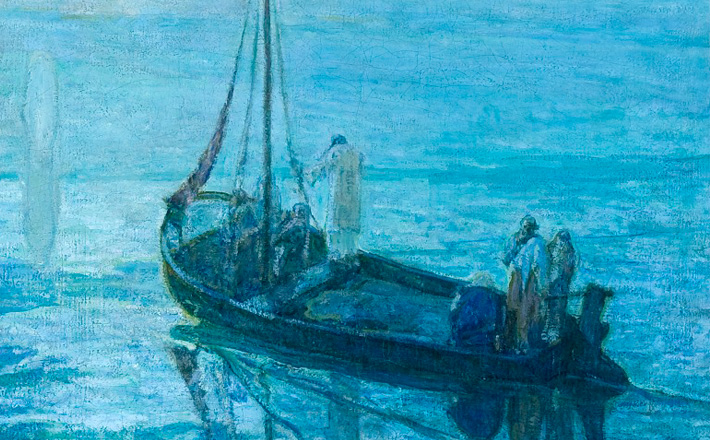Commentary on Psalm 85:8-13
This psalm lection contains a magnificent constellation of biblical terms, portraying them with a striking intimacy that catches modern readers off guard: “righteousness and peace will kiss each other” (verse 10)?
This psalm lection contains a magnificent constellation of biblical terms, portraying them with a striking intimacy that catches modern readers off guard: “righteousness and peace will kiss each other” (verse 10)? We’re more inclined to think of the Song of Songs with a phrase like that! And the theological content: one could write pages of notes on word studies alone!
The presentation of these qualities and actions also provides ample resources for worship leaders to design services that lead God’s people in praise and reflection. There is, however, a significant challenge when these six verses are isolated from their context, and conscientious interpreters need to integrate the theological insights of verses 8-13 with their larger literary setting, without appearing to preach the whole psalm.1
The interpretive difficulty of the psalm begins with the first verse: what precisely is the historical setting behind the words, “Lord, you were favorable to your land; you restored the fortunes of Jacob” (verse 1, NRSV)? And, if we can find a sufficiently clear answer to that question, what relationship does that context have to the profound theological declarations of the second half of the psalm?
Occasionally a scholar has suggested a pre-exilic date,2 but most commentators identify exilic or postexilic settings,3 depending on whether the key Hebrew term šûb (verses 1, 3, 4, 6, 8) is a reference to the Babylonian exile (“restored the captivity,” KJV, NASB) or a more general restoration of fortunes, as in the NRSV citation earlier in this paragraph. In my view a preacher can be non-committal about nearness to the exile but at least ought to call attention to the repetition and wordplay of “restore,” “turn,” and “return.”4
The psalmist interprets God’s restoration of Israel’s fortunes (verse 1) as a turning toward his people (verse 3), in particular, to those who turn to him” (verse 8). It is this group of “faithful” who are able to experience the manifestation of divine life within their own lives. God’s character, while consistent in its fundamental goodness to all (see Psalm 145), is most appreciated and enjoyed by persons of faith who grasp the wonder of God’s steadfast love (hesed) and begin to practice it in human relationships.
These literary connections are vital because even a careful engagement with verses 8-13 might be tempted to maneuver around the concrete historical reality of Israelite experience with the God. A fruitful Christian reading of this psalm might be to place the doctrine of salvation from Romans 10:5-15 (epistle reading for today) in conversation with Israel’s understanding of God’s grand purposes for their nation and the cosmos. But when focusing mainly on Psalm 85:8-13, I see at least these three considerations for interpretation.
First, with respect to the terms of verse 10 (steadfast love, faithfulness, righteousness, and peace), there is great value and necessity in exploring their meaning individually; but there is a greater need to communicate the way they work together as part of a theologically significant semantic field. The composite picture of their “meeting” and “kissing,” “springing up” and “looking down,” illustrates a world in harmony, especially in the arena of human justice.
Just as the attributes of God are not in conflict with each other, the biblical vision of re-creation is that the same qualities would become fully integrated in human relationships.5 When they are not held together, the prophets indicted the people: “Justice is turned back, and righteousness stands at a distance … uprightness cannot enter. Truth is lacking … (Isaiah 59:14-15).
Second, given several references to the “land” or “ground” (verses 1, 9, 11, 12), we cannot miss the connection between the justice enjoined by God’s law and the renewal of the earth envisioned by the prophets. Hosea 2:19-20 contains a cluster of terms similar to those in Psalm 85:10-11, and it is explicit about the creational impact when humankind lives in harmony with itself and its creator.
Reminiscent of the creation story in Genesis 12 and the Noahic covenant in Genesis 9:8-17, Hosea declares: “I will make for you a covenant on that day with the wild animals, the birds of the air, and the creeping things of the ground; and I will abolish the bow, the sword, and war from the land … ” (2:18).6
Finally, building on the first two points, this psalm offers an eschatological perspective as a word of hope to the people who have prayed in verse 4: “Restore us again, O God of our salvation.” This word from God (verse 8, “let me hear what God the Lord will speak”) does not have to be taken itself as an oracle of God, but it certainly draws on oracles such as those in Isaiah 40-55.7
This prophetically-minded psalmist gives us language of hope before the prayer has been completely answered. That hope also arises at the conclusion of Psalm 23, where the faithful one is pursued by the same tob and hesed celebrated by Psalm 85.8
The desire for “restored fortunes” often had an eschatological sense as well as a temporal returning to the land from captivity.9 Christian worship, too, is an occasion for hearing the word of the gospel break into the midst of loss, famine, war, and all sorts of disasters. Although we are certain of the reality of Christ’s present lordship over heaven and earth, this psalm’s provides language for trusting that heaven and earth will someday meet and kiss, uniting God with creation (Revelation 21:1-4), and finally remedying “the ongoing brokenness of the world and the sinfulness of persons and of our society.”10
Notes:
1 The entire psalm is read in Year C (Proper 12 – 10th Sunday after Pentecost), but the two other occasions focus on the psalm’s conclusion.
2 Mitchell Dahood, Psalms II: 51-100, Anchor Bible (Garden City, NY: Doubleday Inc. 1968), 286.
3 John Goldingay, Psalms: Volume 2: Psalms 42-89 (Grand Rapids: Baker Academic, 2007), 605; Artur Weiser, The Psalms: A Commentary, trans. Herbert Hartwell (Philadelphia: Westminster Press, 1962), 571; Marvin E. Tate, Psalms 51-100 (Waco, TX: Word Biblical Commentary, 1990), 368.
4 For a complete study of OT examples of this images, see John M. Bracke, “šûb šebût: A Reappraisal” ZAW 97 (1985): 233-244.
5 Geoffrey W. Grogan, Psalms, Two Horizons (Grand Rapids: Eerdmans, 2008), 151; James Luther Mays. Psalms, Interpretation (Louisville: John Knox Press, 1994), 277.
6 Konrad Schaefer, Psalms, Berit Olam (Collegeville, MD: Liturgical Press, 2001), 210.
7 Mays, 277.
8 I owe this insight to Tara Woodward.
9 Bracke, 234.
10 J. Clinton McCann, Jr., “The Book of Psalms” in NIB, vol 4 (Nashville: Abingdon, 1996), 1018.


August 10, 2014